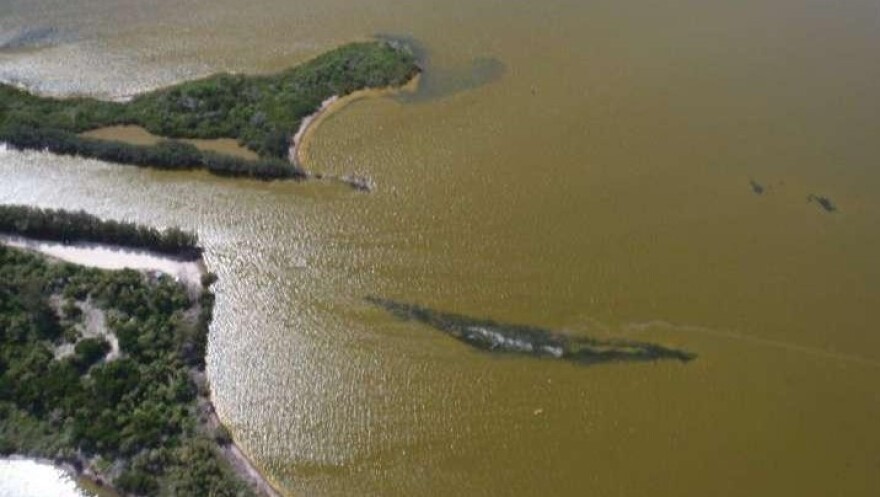Over the past decade nearly 90,000 tons of sewage sludge have been trucked up from South Florida and dumped into the St. Johns River watershed and conservationists say it’s having a devastating effect.
In 2007 the Florida legislature gave the waters of South Florida special protections, essentially banning the land disposal of sewage sludge, the byproduct of wastewater treatment facilities, in the Lake Okeechobee watershed. The legislation was a response to the nutrient pollution that was seriously degrading the lake’s water quality.
Since that ban, more than 89,000 tons of sewage sludge have been dumped into the St. Johns River watershed and, according to Lisa Rinaman, the St. Johns Riverkeeper, “that’s having a devastating effect on the headwaters of the St. Johns and will also have downstream impacts as it flows our way.”
Related: Environmental Groups Accuse JEA Of Causing 'Serious Harm' To St. Johns River
That sewage sludge is being dumped in agricultural land near the headwaters of the St. Johns River. According to Rinaman, that practice is being pitched as an opportunity to provide free fertilizer. “The idea is to provide free fertilizer to farmers, but what we’re seeing is it’s a cheap disposal opportunity for utilities and the volumes are just overwhelming the soil and, in effect, the waterways.”
That’s because the nutrients in the soil runoff into the river. Phosphorus, which the sewage sludge has in abundance, is one of the main problem causers. “Phosphorus is one of the nutrients that fuels green toxic algae,” Rinaman said.” So we’re seeing toxic algae outbreaks in areas we’ve never seen it before in the St. Johns.”
The St. Johns River is more than 310 miles long. It begins in Indian River County, just west of Vero Beach. It only drops in elevation by about 27 feet over that 310 mile journey, and most of that drop is in the first 100 miles - the area where the sewage sludge is being dumped.
“What happens, when you dump it in the headwaters, it all flows this direction,” Rinaman said. “And then there’s more pollution added on to it due to septic tanks in areas, agricultural runoff, urban fertilizers… So it’s just adding fuel at the very beginning of this snowball effect of nutrient pollution that begins now in the headwaters and makes its way to the St. Johns here in Jacksonville.”
“About 96 percent of the nutrient pollution in the middle St. Johns comes from the headwaters and about 80 percent in the lower St. Johns comes from the middle basin,” said Rinaman. “So you can see it just continues to flow downhill.”
Rinaman said that doesn’t just undermine the water quality of the St. Johns River, it also undermines economic investments being made on the river’s behalf. “We’ve been investing public dollars in trying to get this pollution out, trying to reduce our risk of toxic green algae."
And that toxic green algae also has impacts on human health. According to Rinaman, physical contact with the highly toxic algae can have an impact on the liver, it can cause respiratory issues and it can lead to skin irritation.
“The hope was to protect the waters in South Florida, but, unfortunately, there wasn’t a lot of forethought on where this pollution would go,” Rinaman said. “In fact, the utilities in South Florida can charge an environmental protection fee that gives them money to transfer this sludge to our watershed. But they didn’t look at those unintended consequences.”
“When you have a large concentration of this sewage sludge in one area, like we’re seeing in the headwaters, then there is this high runoff, and that wasn’t in consideration during the time that they made those special protections for South Florida,” she said. “So what we’re asking the legislature for now is equal protection for all of Florida’s waterways.”
In response to public outcry, the Florida Department of Environmental Protection formed a Biosolids Technical Advisory Committee (TAC) to look into the issue.
“The state of Florida is growing [in population] and right now we don’t have a sustainable management plan for our waste,” Rinaman said. “This technical committee is looking at ‘what do we need to do differently? Are there new technologies out there? And how can we protect our waterways equally across the state?’”
But, according to the St. Johns Riverkeeper Headwaters Advisory Council, the Biosolids TAC is mostly made up of people from South Florida, four of the seven members benefit financially from the sewage dumping and there isn’t a single representative on the committee from the areas that are being adversely affected.
The council, which includes representatives from several Central and Northeast Florida counties, is urging the state to consider alternatives to the practice of dumping sewage sludge in the St. Johns River watershed.
Some counties, like Indian River County, have been landfilling their sewage sludge. “But that’s not long term either,” Rinaman said. “There are challenges with space.”
Another option is to take the sewage sludge and treat it, but Rinaman said that still results in the same nutrient runoff problems, “so that’s not quite fixing it either.”
Some communities are looking into new technologies that burn the sewage sludge and convert it into energy. “The best bet would be looking at these new technologies that could truly turn it into something beneficial that wouldn’t have the negative water quality impacts,” said Rinaman.
“I think the moral of this story is we have to look at water quality and water quantity issues holistically, statewide,” Rinaman concluded. “You can’t play whack-a-mole and move the pollution around because you’re going to just move the pollution and have the same problems in a different area. And that’s what we’re seeing here. We have to have long term thinking and not just short term, bandaid approaches.”
Brendan Rivers can be reached at brivers@wjct.org, 904-358-6396 or on Twitter at @BrendanRivers.





